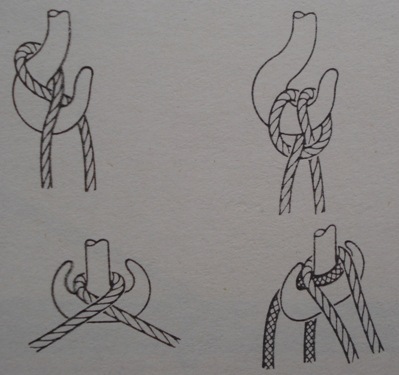Knowledge of knots is essential for safe use of ropes as safety of persons and material depends on selection of a knot for the particular application and quality of knot. Making the knot requires skill and experience. Information on parts of a rope, different types of important knots used in rigging and method to tie them are given in this article.
Parts of a Rope
In order to work with ropes, it is required to know different parts of a rope. The main parts of a rope are as under:
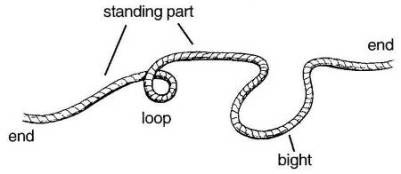
Working end: The end of the rope you are using to tie a knot.
Standing end: The end of the rope opposite to that being used to tie the knot.
Standing part: Any part between the two ends.
Loop: A loop made by turning the rope back on itself and crossing the standing part.
Bight: A loop made by turning the rope back on itself without crossing the standing part.
Learning to Tie a Knot
The only way to learn how to tie knots is to practice. Follow following steps when learning to tie a knot from a drawing.
- Look at the drawing. Trace the various twists, crosses and bends with your eye from the standing part to the working end to see how the knot is constructed.
- Lay your rope on a flat surface and take hold of a point 30cm from the working end.
- Make the first bend, turn or crossover in the rope and then move along to the next.
- Look at the drawing of knot and compare your work with them.
- Try each knot using the drawing few times and then try it from memory.
Important Knots and Method of Tying
Important knots used in rigging and method to tie them are as under.
Figure of Eight
This is a 'stopper knot' that is unlikely to jam or pull loose. This knot is used at the end of a rope to temporarily prevent the strands from unlaying.
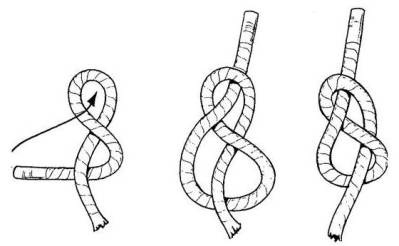
Steps to tie the knot are as under.
- Form a loop in the end of a rope.
- Take the working end behind the standing part and back over itself into the open loop.
- Finish by pulling both sides of the knot tight. The knot look like a ‘figure of eight'.
Reef Knot
This knot is used to tie together two working ends of the same material and size. If tied with two ends of unequal size, or if one end is stiffer or more slippery than the other, it is bound to open up. Be careful while using this knot. There have probably been more lives lost as a result of using a reef knot as a bend (A bend is tying two ropes together).
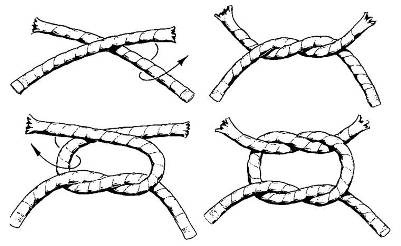
Steps to tie the knot are as under.
- Take an end of rope in each hand and lay the left hand end over the right.
- Then, using your right hand, take the end from the left down behind the other rope and up to the front again.
- Point the ends inwards again, this time the right hand one over the other one, then take it down behind it and up to the front through the loop which has now been formed.
- Pull the knot tight.
This knot is also known as square knot and often remembered by, 'left over right and right over left'.
Sheet Bend
The 'sheet' is the sailor's name for a rope. The sheet bend is used to tie together two ropes of different types or unequal thicknesses. The knot is also known as weaver’s knot.
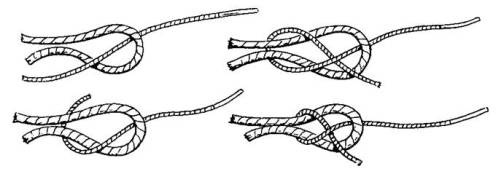
Steps to tie the knot are as under.
- Form a bight in the working end of the thicker rope. Take the working end of the thinner rope and pass it up through the bight.
- Take the thinner rope round the back of the bight and trap it under itself. Remember not to take the working end back down the bight in the first rope.
- Pull tight by holding the bight in one hand and pulling the standing part of the second rope with the other.
Make sure the two ends are on the same side of the knot. If the ropes are of very different thickness, take the working end round the bight and under itself twice to form a double sheet bend.
Round turn and two half-hitches
This hitch is used to attach a rope to a post, tree, etc. It is a composite knot formed from two simple knots.
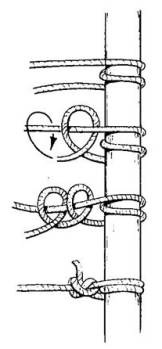
Steps to tie the knot are as under.
- Form a round turn by turning the working end twice around the post.
- Then form a half-hitch by taking the working end around the standing part forming a crossed loop.
- Repeat to form a second half-hitch. These should be tied in the same direction and tightened up against the post to ensure that the round turn doesn't slip.
Clove Hitch
The clove hitch is another method of 'hitching' a rope to a post. It is not as secure as the round turn and two half-hitches.
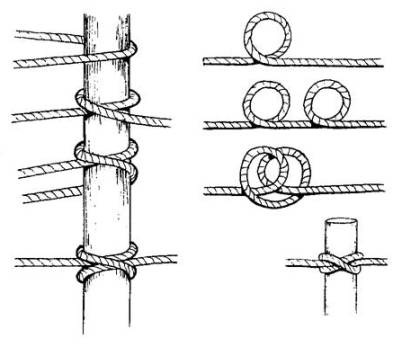
Steps to tie the knot are as under.
- Pass the working end over and under a rail.
- Run it across the standing part at the front.
- Continue round the rail again and bring the working end back to trap it under the diagonal.
As shown above, the two ends of the rope should be laid next to each other under the diagonal but running in opposite directions. The clove hitch looks like a 'N'.
Timber Hitch
The timber hitch is a temporary knot used to drag, tow or lift a log or pole.
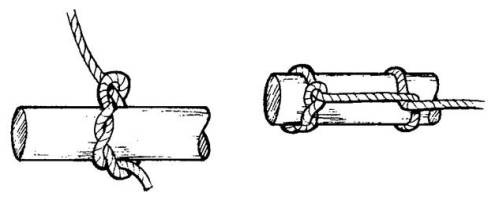
Steps to tie the knot are as under.
- Turn the working end round the standing part and then wrap it around itself at least four or five times.
- A half-hitch can be tied in the standing part further up the log or pole to add some security.
- The log is dragged by pulling the standing end.
Highwayman's Hitch
This hitch is a 'slip hitch'. Pulled on the standing end it holds fast. Pulled on the working end it comes free. Thus it is used to tie a boat to a mooring ring or an animal to a rail or post.
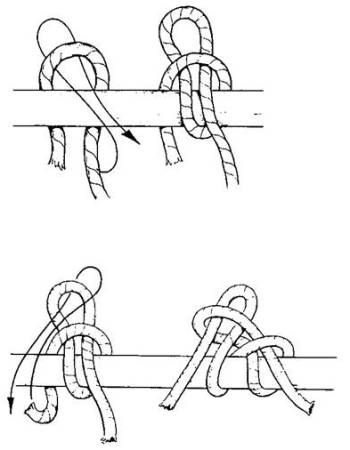
Steps to tie the knot are as under.
- Start by passing a bight behind the rail.
- Take another bight in the standing part and pass it in front of the rail and through the first bight.
- Pull tight on the working end.
- Then take a third in the working end and pass it in front of the rail- and through the second bight.
- Pull tight on the standing part.
Hitches and knots for endless fibre ropes
Use hitches and knots for endless fibre ropes as shown below.
